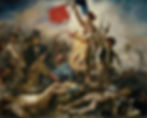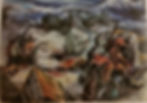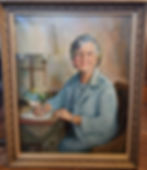Artwork: Another Tool for Historians
- LCHS
- Jan 10, 2024
- 6 min read
By Hayley Noble, LCHS Executive Director
Artwork has long been an important primary source for historians to understand the past. Many historical eras are embodied in famous works of art commissioned by heads of state or churches. With the advent of photography, some might wonder why art continues to be used as a historical document to uncover the past. I first came to the concept of art as primary sources when researching combat art to document military events. Art made sense before photography to capture the battlefields of the Civil War or World War I, but combat art persisted even after the invention of cameras and film. The military created extensive combat art collections during World War II and the Vietnam War, and combat artists continue to be used on battlegrounds today. More broadly, I wanted to explore the use of art to historians, while also connecting my prior research into combat art and military history.

Historically, art has been used to capture specific moments in time, most often significant events in religious or political history. Whether the sequence of events happened exactly as portrayed is debatable, but the art clearly conveys a momentous achievement. In an age without cameras or film, these massive works of art can shed light on these events, or in the very least, reveal the biases of the artist or commissioner. Because much of this kind of art was commissioned by the state or church, artists were confined in their representations portrayed and, of course, each artist is going to see events differently. The church or state is always going to want their actions portrayed in favorable light and is not going to pay an artist if they deviate from that path. One example is The Coronation of Napoleon by Jacques-Louis David finished in 1808. Napoleon resented the monarchy and after staging a military coup, he seized power and crowned himself emperor of France. Part of legitimizing his role of emperor included hiring David as his official painter and hosting an elaborate coronation ceremony in Notre Dame, where the pope presided. David’s work is massive and can effectively be viewed as propaganda, seen as part of legitimizing Napoleon’s claim to being France’s rightful ruler.
Works not commissioned but done simply for artistic expression can be free of some of the limitations placed upon officially sanctioned works. That’s not to say an artist will never have biases, but we understand the influence that powerful people and institutions can have on their perceived public image. Of course, all of these factors are considered when historians view art as primary sources. The context surrounding the artwork is just as important as the work itself.

Art can also capture abstract concepts and allegory in visual forms. In Liberty Leading the People by Eugene Delacroix, allegorically “Liberty” is personified as a woman leading the French people during the French Revolution of 1830. The entire premise of the French Revolution and its many stages was to literally give power to the people and overthrow the systems of oppression - namely the monarchy. To historians, this work illustrates Delacroix’s contribution in his mind to the revolution, with a quote often attributed to him stating, “And if I haven't fought for my country at least I'll paint for her.”
Art does not have to follow the literal sequence of events to evoke emotions or communicate ideas. The artwork does not even have to be realistic. One of the most famous abstract works by Pablo Picasso is Guernica which illustrates the horrors of the bombing of the Basque city Guernica during the Spanish Civil War in 1937. The work details the horror of the bombing and the toll on civilians and animals. The art is abstract, but the emotions transcend the stylistic choices, and the message is clear despite the “unrealistic” nature of the piece.

With the invention of photography, one would assume that art would cease to be used as a documentary practice, but that is not the case. Even more contemporary pieces of art can still be useful to historians as sources, providing clues about the past, even when photography exists. Artists are able to take images and interpret them. Cameras place equal emphasis on all elements in the picture, while artists can make choices to rearrange or eliminate elements to emphasize what the artist deems important. This could be seen as problematic regarding the detailed reliability of the artist’s work. But as part of the larger whole, this art adds to the narrative much in the way that oral history accounts supplement historical research. More importantly, this freedom allows artists to imprint their personality, an exclusive way of expressing themselves, and give their work unique individual qualities. Two artists may witness the same event, but their different interpretations and experiences could result in vastly different works, both significant to our understanding of the event in question. Artists evoke emotion in their pieces and help others understand the subject of the work in a myriad of ways. Some may think that using art in this way could be misleading, but when consulted in conjunction with other primary sources, we glean a more complete picture of what the past was like, whether it was photographed or not. Truth, accuracy, and authenticity in regard to art and history form a much larger, philosophical conversation that is not the focus of this article.
Additionally, in the early days of photography, photos were reserved for the upper classes of society, and film was not always available for the everyday or “mundane” aspects of life. Art could capture those “lesser” aspects of life and make just about anything the subject of a piece. Artists are also not confined to the limitations of photography, capturing night action, bad weather, and other occurrences that may not translate well in photography. Of course, the advancement of technology means that cameras are ever improving, and these limitations may not exist in the future.

In my original research looking into combat art, I wondered why the government developed its own military art program during World War I, even though by that time photography was prevalent. I found that it was because of all the reasons stated above. Artists could invoke human emotion in the artwork that spoke to the universality of combat experiences. The military expanded its art programs in both World War II and the Vietnam War because of all these factors. The military also liked that artists could omit confidential technical details from their work that the camera might reveal, thus making otherwise useless images available for publication. It’s also worth noting that during World War I and II, the state used some of the artwork for propaganda purposes as well. Artists could translate their experiences for home front audiences and that was an effective tool in selling war bonds. For that reason, some pieces were censored with the government only wanting “heroic” pieces created. Those restrictions lessened throughout Vietnam, and what resulted were powerful pieces illustrating the pain, boredom, and universality of war in Vietnam. The work displays the experiences of both officers and infantrymen, those in combat, and those in the rear.
Another example of artwork used in contemporary times to document is during courtroom proceedings. In many cases, cameras are prohibited in courtrooms, so artists are used to sketch what they see, documenting trials when cameras cannot.

Now we do not have any vast historical pieces or works of combat art in the Latah County Historical Society art collection, but we do have some landscapes, portraits, and still lifes, which can still prove valuable for historians. Many of the works in the collection may not depict a scene in Latah County, but the artist personally may be an important figure in our history. A few of the artists in the LCHS collection are Minnie Taylor Lauder, Alf Dunn, Audrey Barr, Mary Kirkwood, and Sara Annette Bowman. Their works are preserved in our archive due to their important standing within the community and the larger legacy of art and artists in Idaho and the Palouse. Carol Ryrie Brink is best known as an author but was also an artist. We have a few of her works, including a self-portrait, which provides an interesting glimpse of how she viewed herself. Another piece in our collection is a landscape of hills near Moscow thought to be Tomer Butte painted by Marian Featherstone from 1946 - 1947. The roughly 75-year-old piece could lend clues about how the landscape has changed, especially since we have few photos of the butte from that time. This could be particularly useful as our natural resources and farmland are threatened by climate change and development.

Whether someone is looking at a large, historical painting, a portrait, a landscape, or combat art, each piece provides insight that can be useful for those wanting to know more about history. Art and history go hand in hand, each lending context to the other. Artist’s interpretation of events or scenes adds to that context, layering emotions, biases, and artistic choices embedded in the works. Art as primary sources made perfect sense before the invention of photography, but art has continued to document historical events and everyday scenes, providing historians with clues about the past.
